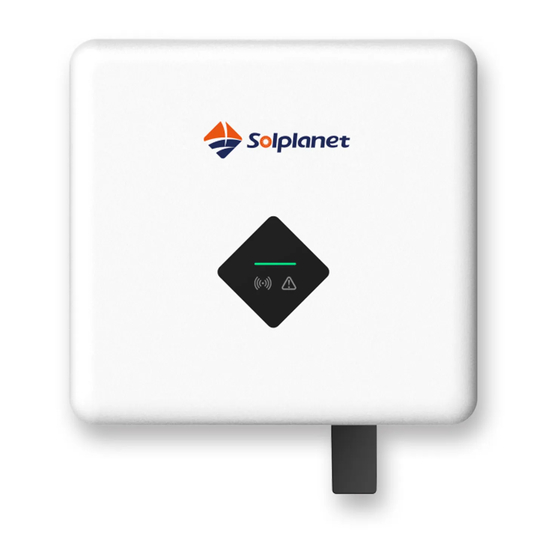
Table of Contents
Advertisement
Advertisement
Table of Contents

Summarization of Contents
Notes on this Manual
General Notes
Overview of the inverter and its function as a transformerless solar inverter.
Area of Validity
Specifies the inverter models covered by this manual: ASW3000-S, ASW3680-S, ASW4000-S, ASW5000-S.
Target Group
Identifies qualified electricians and required skills for installation and operation.
Symbols Used in this Manual
Explains the meaning of safety symbols like DANGER, WARNING, CAUTION, NOTICE, and INFORMATION.
Safety
Intended Use
Defines the correct and intended applications for the inverter, suitable for indoor/outdoor use.
Important Safety Information
Details critical safety precautions for handling high voltages, electric shock, and hot surfaces.
Symbols on the Label
Explains various symbols found on the inverter's label, including danger zones and certifications.
Unpacking
Scope of Delivery
Lists all items included in the product packaging, such as inverter, bracket, and accessories.
Checking for Transport Damage
Provides instructions for inspecting the packaging for shipping damage upon delivery.
Mounting
Ambient Conditions
Specifies environmental requirements and clearance for inverter installation.
Selecting the Mounting Location
Guidance on choosing the appropriate physical location and orientation for mounting the inverter.
Mounting the Inverter with the Wall Bracket
Step-by-step instructions for attaching the inverter to a wall using the provided mounting bracket.
Electrical Connection
Safety
Crucial safety warnings regarding high voltages, electric shock, and electrostatic discharge.
System Layout of Units without Integrated DC Switch
Illustrates system architecture for units lacking an integrated DC switch, requiring external switches.
Overview of the Connection Area
Identifies and describes the various connection ports and interfaces on the inverter unit.
AC Connection
Details the AC connection requirements, including cable specifications and protection.
Conditions for the AC Connection
Specifies cable requirements, design, residual current protection, and circuit breaker selection.
Grid Connection
Details safety procedures and steps for connecting the inverter to the electricity grid.
Second Protective Grounding Connection
Outlines the procedure for establishing a second protective ground connection as per safety standards.
DC Connection
Safety warnings and requirements for connecting the DC power from the PV array.
Requirements for the DC Connection
Specifies requirements for PV modules, string configuration, and input voltage/current.
Assembling the DC Connectors
Safety warnings and step-by-step instructions for assembling the DC connectors.
Disassembling the DC Connectors
Safety warnings and instructions for safely disconnecting and disassembling the DC connectors.
Connecting the PV Array
Notice regarding overvoltage protection and procedure for safely connecting the PV array.
Communication
System Monitoring via RS485/ Ethernet
Details on monitoring the inverter system using RS485 or Ethernet communication interfaces.
System Monitoring via WLAN
Guidance on monitoring the inverter system using a Wi-Fi connection and modular.
Inverter Demand Response Modes (DRED)
Explains the inverter's demand response capabilities, available modes, and requirements.
Active Power Control with Smart Meter & AiCom/AiManager
How to control active power output via smart meters and AiCom/AiManager in the system.
Communication with Third-Party Devices
Information on communicating with external devices like Solarlog or Meteocontrol.
Earth Fault Alarm
Describes the inverter's earth fault monitoring function, alarm indicators, and error codes.
Commissioning
Electrical Checks
Essential electrical tests including PE connection, DC voltage, polarity, and insulation resistance checks.
Mechanical Checks
Mechanical inspections to ensure the inverter's water-tightness and correct mounting.
Safety Code Check
Procedures for checking and setting the safety code, including region selection for Australian market.
Start-Up
Steps to initiate the inverter's operation, including switching on the circuit breaker and states.
Operation
Overview of the Panel
Introduction to the inverter's control panel and its components.
LEDs
Explanation of the function of each LED indicator (Normal, Communication, Fault) on the inverter.
Disconnecting the Inverter from Voltage Sources
Disconnecting the Inverter from Voltage Sources
Procedure for safely disconnecting the inverter from all voltage sources before performing work.
Technical Data
DC Input Data
Specifications for the inverter's DC input, including voltage, current, and power ratings.
AC Output Data
Specifications for the inverter's AC output, including power, voltage, current, and harmonic distortion.
General Data
General technical specifications like dimensions, weight, operating temperature, and protection degree.
Safety Regulations
Details the safety regulations, protective devices, and EMC compliance standards for the inverter.
Tools and Torque
Lists the required tools and specific torque settings for installation and electrical connections.
Troubleshooting
Troubleshooting
Guide to identifying and resolving common inverter faults and error codes.
Maintenance
Cleaning the Contacts of the DC Switch
Procedure for annual cleaning of the DC switch contacts to ensure proper function.
Cleaning the Heat Sink
Instructions for cleaning the inverter's heat sink to ensure adequate cooling and performance.
Recycling and Disposal
Recycling and Disposal
Guidelines for proper disposal of the inverter and packaging according to electronic waste regulations.
EU Declaration of Conformity
EU Declaration of Conformity
Statement confirming compliance with relevant EU directives like EMC, LVD, and RED.
















Need help?
Do you have a question about the ASW4000-S and is the answer not in the manual?
Questions and answers